
Del Mar Photonics Newsletter Spring 2007

Product updates
New products and services
|
|
In vivo cell and tissue
imaging with Mavericks Del Mar Photonics, Inc. expands in vivo cell and tissue imaging capabilities with Mavericks, a long wavelength femtosecond laser. With wavelength tunable within the range of 1.21 - 1.29 mm, Mavericks combines the advantages of femtosecond optical engineering and fiber-optic technologies. Cr:forsterite can be directly pumped with ytterbium fiber laser, offering a significant reduction in system cost. Mavericks use as a pump fiber lasers manufactured by IPG Photonics, which are compact, feature high conversion efficiency, and their output power exceeds 10 W for an operating life more that 10,000 hours. In addition a high quality and stability of the laser beam emitted provide a convenient and reliable coupling of its radiation to the resonator of a femtosecond laser. more - applications in semiconductor research - request a quote |
|
|
Femtosecond Ti:Sapphire oscillator and
amplifier Teahupoo Rider Del Mar Photonics announced a new integrated oscillator/amplifier system Teahupoo Rider. Teahupoo Rider is a fully-integrated all-in-one-box system that includes Trestles Finesse oscillator or Buccaneer SHG diode-pumped fiber oscillator, pulse stretcher, regenerative amplifier pumped by multi kHz Nd:YAG pump laser and pulse compressor. Teahupoo Rider has a factory preinstalled repetition rate of 2, 5 or 10kHz and ideal for low cost femtosecond micromachining systems, OPA pumping, ultrafast spectroscopy and variety of applications in life sciences. request a quote |
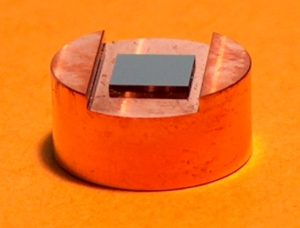 |
Saturable Absorber Mirror (SAM) A passive mode-locking device, the saturable absorber mirror (SAM), can be used to mode-lock a wide range of laser cavities. A SAM consists of a Bragg-mirror on a semiconductor wafer like GaAs, covered by an absorber layer and a more or less sophisticated top film system, determining the saturable loss. Although semiconductor saturable absorber mirrors have been employed for mode-locking in a wide variety of laser cavities, the SAM has to be designed for each specific application. The differing loss, gain spectrum, internal cavity power, etc, of each laser necessitates slightly different absorber characteristics. Our online store has a wide selection of SAMs with a typical lead time of only one week. |
 |
LabView drivers for photonics instrumentation Del Mar Photonics software development team now offers custom NI LabVIEW application and drivers to your requirements. National Instruments LabVIEW is now the most widely used graphical development environment for test, measurement and control applications. We develop software for instrument automation, data acquisition, and vision inspection. Our company have a number of people with scientific backgrounds, thus we understand the peculiarities of the scientific world that’s why we create software for scientific automation and for data analysis which are efficient and reliable. We also proficient in other languages including C, C++, C#, .NET and Visual Basic. Please contact us to discuss your requirements today. Programming job can be quoted and paid as PO based on 30 days net payment terms, or programming hours can be prepaid online and used as required. |
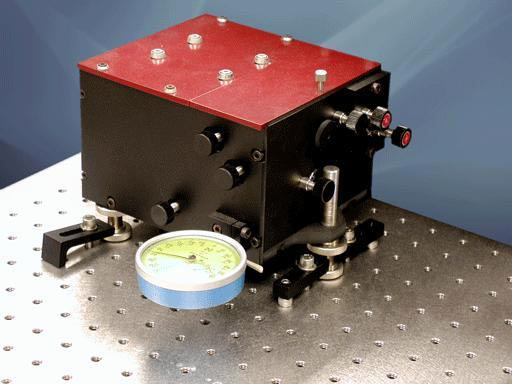 |
Lead time on a number of products have been
substantially reduced The following products are available now with shorter lead times: Mavericks femtosecond Cr:Forsterite laser - 2 - 4 weeks - pdf brochure - specification sheet - request a quote Femtosecond Autocorrelator Reef RT AA-10D - 2 weeks - pdf brochure - specification sheet - request a quote Second harmonic unit – 2 weeks - pdf brochure - specification sheet - request a quote Kirra Farday isolator 5AFI60-780G with 60dB isolation. - 2weeks - pdf brochure - specification sheet - request a quote |
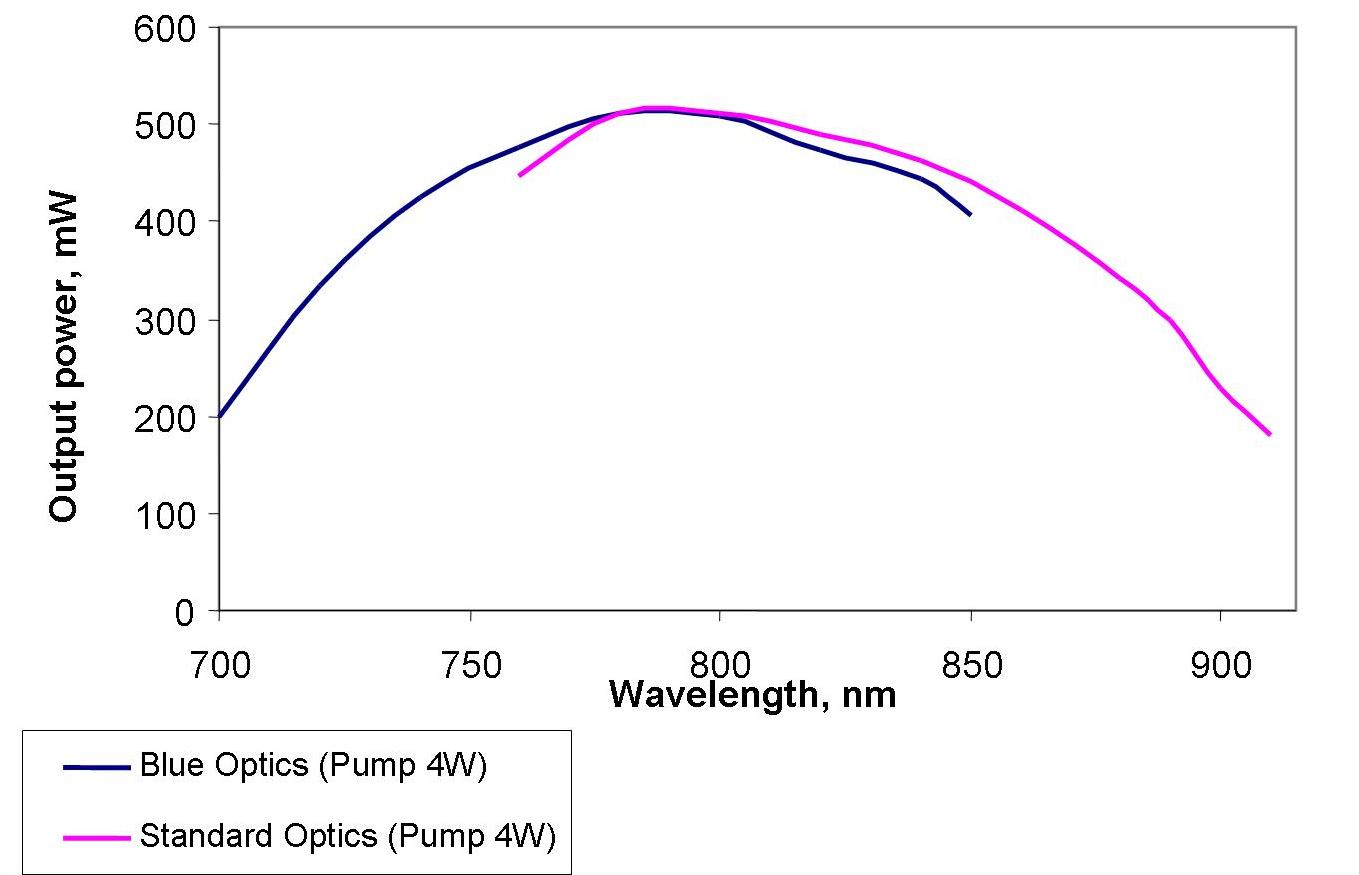 |
Del Mar Photonics Ti:Sapphire laser
lease program helps Physical Optics Corporation in Phase I and Phase II
Army awards -
request info on lease program To address the U.S. Army need for new techniques for detecting concealed explosives, Physical Optics Corporation (POC) proposes a new 100 m standoff Terahertz Spectroscopic Radar (TSR) which uses terahertz (THz) molecular spectroscopy to detect the unique THz absorption wavelength signature of an explosive's outgassed material. This design exhibits the most decisive identification pattern of explosives, whose molecular vibration modes lie in the THz region. To detect these specific explosive identifiers, TSR's innovative design analyzes the retroreflected THz signals from targets rather than the transmitted THz signals common to the conventional spectroscopy performed inside a laboratory. The TSR design combines a wideband (1-20 THz) transmitter and a receiver spectrometer, built on a mobile station. Using a high-quality submillimeter wave radar to send high rep-rate (~100 MHz) THz probing pulses, we can identify not only the explosive but also the location of the target with spatial resolution better than 0.03 mm since our radar pulsewidth is faster than 100 femtosecond (fs). The average power of our source is exceptionally high (~100 W) compared with any other THz sources. In Phase I we will build a preliminary TSR prototype, while Phase II will focus on a full engineering prototype. more |
|
|
Our online store offers many precision
optical components from stock We offer variety of fused silica optics from stock including right angle prisms from 5x5x5 mm to 50x50x50 mm, dispersion and Dove prisms, as well as lenses and windows of different sizes. Prisms from other materials such as BK-7 glass, SF6, CaF2 and rutile (TiO2) are also available in stock. Other items available from stock are: LiNbO3 crystals and wafers including stoichiometric z-cut LiNbO3 wafers (2" diam, 1mm thick) more details - buy online |
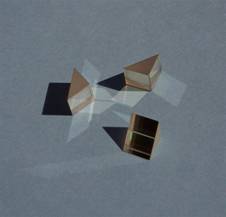 |
Rutile (TiO2) coupling prisms Del Mar Photonics offers optical elements made of high quality synthetically grown Rutile Titanium Dioxide crystals. Rutile’s strong birefringency, wide transmission range and good mechanical properties make it suitable for fabrication of polarizing cubes, prisms and optical isolators. Boules having high optical transmission and homogeneity are grown by proprietary method. Typical boules have 10 - 15 mm in dia. and up to 25 mm length. Optical elements sizes - from 2 x 2 x 1 mm to 12.7 x 12.7 x 12.7 mm. Laser grade polish quality is available for finished elements. So far we the largest elements that we manufactured are 12 x15 x 5 mm, in which optical axis is parallel to 15 mm edge, 5 mm is along beam path, 12 x 15 mm faces polished 20/10 S/D, one wave flatness, parallelism < 3 arc.min. (better specs. available on request). more details - buy online - download brochure |
Featured customers
|
|
Francisco Bezanilla
uses Del Mar Photonics
THG generator and
Pismo pulse picker in his
experiments on measuring intramolecular distances with fluorescence
resonance energy transfer (FRET). The interest in Francisco Bezanilla lab is the search for the molecular basis of the voltage sensor operation in voltage dependent channels and the molecular basis of nervous system adaptation. The molecular basis of excitability is being approached with physical techniques such as temperature effects and complex capacitance measurements in the frequency domain in engineered channel molecules and assessed by gating currents, macroscopic currents and single channel recordings. The correlation with structural changes are being monitored with optical fluorescence techniques from probes attached to strategic sites in the channel molecule to determine light intensity changes and measuring intramolecular distances with fluorescence resonance energy transfer. The adaptation is studied as a correlation of RNA editing in membrane proteins and their physiological consequences in related species living in different environments. Del Mar Photonics third harmonic generator ATsG is developed for producing the coherent radiation at doubling and tripling frequency for TiSa femtosecond oscillator sources having output wavelength range from 710 to 960 nm. THG unit pdf brochure - Pismo pulse picker pdf brochure |
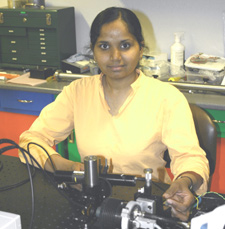 |
Esha Manne, PhD student from University of
Alberta uses Del Mar Photonics Ge etalon for
characterization of the quantum cascade laser and choosing the
right parameters for the laser for gas-sensing applications. The mid-IR
region is ideally suited for absorption spectroscopy since the fundamental vibrational transitions of a number of molecules lie here. Quantum cascade (QC)
lasers
fabricated by band structure engineering offer an attractive
new option for sensitive IR absorption spectroscopy. Distributed feed-back
pulsed QC lasers are of particular interest for they allow the realization of a
room temperature, compact IR source with relatively high output power. In
particular, their combination with the pulsed-CRDS technique
has the potential for high sensitivity trace gas analysis. The goal
of our present work is to develop a technique for quantitative online analysis
of trace constituents in exhaled breath. We are using pulsed-CRDS technique in
combination with a mid IR QC laser operating near 970 cm-1
to measure ammonia levels in exhaled breath. An unlocked
ring-down cavity was designed for these studies which can be operated at
atmospheric or reduced pressure. We have already attained a detection limit of
25 ppb for ammonia. We are in a process of improving the system to get down to
sub ppb levels with this technique. |
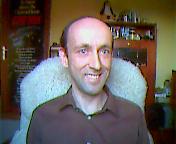 |
Markus Beck
uses Del Mar Photonics
MCP-MA25/2
detectors in the WITCH experiment The WITCH experiment [1] aims to investigate the Standard Model of the electroweak interaction with emphasis on finding new physics beyond the standard model. The primary goal is to search for a contribution of scalar interaction to the vector and axial-vector interaction of the standard model. For this purpose in the WITCH experiment the electron-neutrino angular correlation in beta decay will be determined. This will be achieved by measuring the recoil energy spectrum of the daughter ions after beta decay. |
Featured applications
 |
Negative pre-chirp in multiphoton microscopy In multiphoton microscopy it's important to take into consideration the dispersion of ultrashort pulses in the microscope optics. Short pulse has a broad spectrum. While passing though microscope optics the low frequency part of the femtosecond pulse travels faster than high frequency. As a result original short pulse becomes longer with the low frequency part arriving first to the specimen. This is called chirp. In multiphoton microscopy high intensity of the pulse is required to obtain multiphoton effect. With longer pulses it will be necessary to increase total pulse energy to get to the same intensity level. To avoid potential damage to the sample it's useful to use ultrashort pulses with negative chirp equal to the chirp created by microscope optics. Negative chirp is easy to achieve with simple prism assemblies which are often used to generate and modify femtosecond pulses. read more - buy dispersion prism pairs from stock |
Guess what is that?

If you send us a right answer we'll send you a free Del Mar Photonics mug! Read Del Mar Photonics Spring 2008 newsletter